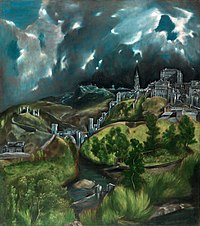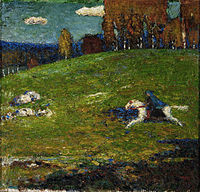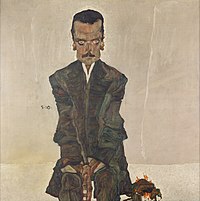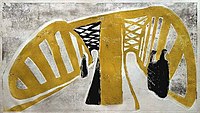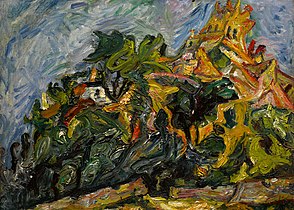Expressionism
 Edvard Munch, The Scream, c.1893, oil, tempera and pastel on cardboard, 91 × 73 cm, National Gallery of Norway, inspired 20th-century expressionists. | |
| Years active | The years before WWI and the interwar years |
|---|---|
| Location | Predominantly Germany |
| Major figures | Artists loosely categorized within such groups as Die Brücke, Der Blaue Reiter; the Berlin Secession, the School of Paris and the Dresden Secession |
| Influenced | American Figurative Expressionism, generally, and Boston Expressionism, in particular |
Expressionism is a modernist movement, initially in poetry and painting, originating in Northern Europe around the beginning of the 20th century. Its typical trait is to present the world solely from a subjective perspective, distorting it radically for emotional effect in order to evoke moods or ideas.[1][2] Expressionist artists have sought to express the meaning[3] of emotional experience rather than physical reality.[3][4]
Expressionism developed as an avant-garde style before the First World War. It remained popular during the Weimar Republic,[1] particularly in Berlin. The style extended to a wide range of the arts, including expressionist architecture, painting, literature, theatre, dance, film and music.[5] Paris became a gathering place for a group of Expressionist artists, many of Jewish origin, dubbed the School of Paris. After World War II, figurative expressionism influenced artists and styles around the world.
The term is sometimes suggestive of angst. In a historical sense, much older painters such as Matthias Grünewald and El Greco are sometimes termed expressionist, though the term is applied mainly to 20th-century works. The Expressionist emphasis on individual and subjective perspective has been characterized as a reaction to positivism and other artistic styles such as Naturalism and Impressionism.[6]
Etymology and history
[edit]While the word expressionist was used in the modern sense as early as 1850, its origin is sometimes traced to paintings exhibited in 1901 in Paris by obscure artist Julien-Auguste Hervé, which he called Expressionismes.[7] An alternative view is that the term was coined by the Czech art historian Antonin Matějček in 1910 as the opposite of Impressionism: "An Expressionist wishes, above all, to express himself... (an Expressionist rejects) immediate perception and builds on more complex psychic structures... Impressions and mental images that pass through ... people's soul as through a filter which rids them of all substantial accretions to produce their clear essence [...and] are assimilated and condensed into more general forms, into types, which he transcribes through simple short-hand formulae and symbols."[8]
Important precursors of Expressionism were the German philosopher Friedrich Nietzsche (1844–1900), especially his philosophical novel Thus Spoke Zarathustra (1883–1892); the later plays of the Swedish dramatist August Strindberg (1849–1912), including the trilogy To Damascus (1898–1901), A Dream Play (1902), The Ghost Sonata (1907); Frank Wedekind (1864–1918), especially the "Lulu" plays Erdgeist (Earth Spirit) (1895) and Die Büchse der Pandora (Pandora's Box) (1904); the American poet Walt Whitman's (1819–1892) Leaves of Grass (1855–1891); the Russian novelist Fyodor Dostoevsky (1821–1881); Norwegian painter Edvard Munch (1863–1944); Dutch painter Vincent van Gogh (1853–1890); Belgian painter James Ensor (1860–1949);[9] and pioneering Austrian psychoanalyst Sigmund Freud (1856–1939).[5]
In 1905, a group of four German artists, led by Ernst Ludwig Kirchner, formed Die Brücke (the Bridge) in the city of Dresden. This was arguably the founding organization for the German Expressionist movement, though they did not use the word itself. A few years later, in 1911, a like-minded group of young artists formed Der Blaue Reiter (The Blue Rider) in Munich. The name came from Wassily Kandinsky's Der Blaue Reiter painting of 1903. Among their members were Kandinsky, Franz Marc, Paul Klee, and August Macke. However, the term Expressionism did not firmly establish itself until 1913.[10] Though mainly a German artistic movement initially[11][5] and most predominant in painting, poetry and the theatre between 1910 and 1930, most precursors of the movement were not German. Furthermore, there have been expressionist writers of prose fiction, as well as non-German-speaking expressionist writers, and, while the movement declined in Germany with the rise of Adolf Hitler in the 1930s, there were subsequent expressionist works.
Expressionism is notoriously difficult to define, in part because it "overlapped with other major 'isms' of the modernist period: with Futurism, Vorticism, Cubism, Surrealism and Dadaism."[12] Richard Murphy also comments, “the search for an all-inclusive definition is problematic to the extent that the most challenging expressionists such as Kafka, Gottfried Benn and Döblin were simultaneously the most vociferous 'anti-expressionists.'"[13]
What can be said, however, is that it was a movement that developed in the early twentieth century, mainly in Germany, in reaction to the dehumanizing effect of industrialization and the growth of cities, and that "one of the central means by which expressionism identifies itself as an avant-garde movement, and by which it marks its distance to traditions and the cultural institution as a whole is through its relationship to realism and the dominant conventions of representation."[14] More explicitly, that the expressionists rejected the ideology of realism.[15]
The term refers to an "artistic style in which the artist seeks to depict not objective reality but rather the subjective emotions and responses that objects and events arouse within a person".[16] It is arguable that all artists are expressive but there are many examples of art production in Europe from the 15th century onward which emphasize extreme emotion. Such art often occurs during times of social upheaval and war, such as the Protestant Reformation, German Peasants' War, and Eighty Years' War between the Spanish and the Netherlands, when extreme violence, much directed at civilians, was represented in propagandist popular prints. These were often unimpressive aesthetically but had the capacity to arouse extreme emotions in the viewer.[citation needed]
Expressionism has been likened to Baroque by critics such as art historian Michel Ragon[17] and German philosopher Walter Benjamin.[18] According to Alberto Arbasino, a difference between the two is that "Expressionism doesn't shun the violently unpleasant effect, while Baroque does. Expressionism throws some terrific 'fuck yous', Baroque doesn't. Baroque is well-mannered."[19]
Notable Expressionists
[edit]Some of the style's main visual artists of the early 20th century were:
- Argentina: Xul Solar
- Armenia: Martiros Saryan
- Australia: Sidney Nolan, Charles Blackman, John Perceval, Albert Tucker, and Joy Hester
- Austria: Richard Gerstl, Egon Schiele, Oskar Kokoschka, Josef Gassler and Alfred Kubin
- Belgium: Marcel Caron, Anto Carte, and Auguste Mambour, and the Flemish Expressionists: Constant Permeke, Gustave De Smet, Frits Van den Berghe, James Ensor, Albert Servaes, Floris Jespers and Gustave Van de Woestijne.
- Brazil: Anita Malfatti, Cândido Portinari, Di Cavalcanti, Iberê Camargo and Lasar Segall.
- Denmark: Einer Johansen, Jens Søndergaard, Oluf Høst
- Estonia: Konrad Mägi, Eduard Wiiralt, Kuno Veeber
- Finland: Tyko Sallinen,[20] Alvar Cawén, and Wäinö Aaltonen.
- France: Frédéric Fiebig, Georges Rouault, Alexandre Frenel, Georges Gimel, Gen Paul, Marie-Thérèse Auffray, Jacques Démoulin and Bernard Buffet.
- Germany: Ernst Barlach, Max Beckmann, Fritz Bleyl, Heinrich Campendonk, Otto Dix, Conrad Felixmüller, George Grosz, Erich Heckel, Carl Hofer, Max Kaus, Ernst Ludwig Kirchner, Käthe Kollwitz, Wilhelm Lehmbruck, Elfriede Lohse-Wächtler, August Macke, Franz Marc, Ludwig Meidner, Paula Modersohn-Becker, Otto Mueller, Gabriele Münter, Rolf Nesch, Emil Nolde, Max Pechstein, Christian Rohlfs, Karl Schmidt-Rottluff and Georg Tappert.
- Greece: George Bouzianis
- Hungary: Tivadar Kosztka Csontváry
- Iceland: Einar Hákonarson
- Ireland: Jack B. Yeats
- Indonesia: Affandi
- Israel: Isaac Frenkel Frenel
- Italy: Amedeo Modigliani, Emilio Giuseppe Dossena
- Japan: Kōshirō Onchi
- Lebanon: Rafic Charaf
- Mexico: Mathias Goeritz (German émigré to Mexico), Rufino Tamayo
- Netherlands: Willem Hofhuizen, Herman Kruyder, Jan Sluyters, Vincent van Gogh, Jan Wiegers and Hendrik Werkman
- Norway: Edvard Munch, Kai Fjell
- Poland: Henryk Gotlib
- Portugal: Mário Eloy, Amadeo de Souza Cardoso
- Russia: Wassily Kandinsky, Marc Chagall, Chaïm Soutine, Alexej von Jawlensky, Natalia Goncharova, Mstislav Dobuzhinsky, and Marianne von Werefkin (Russian-born, later active in Germany and Switzerland).
- Romania: Horia Bernea
- Serbia: Nadežda Petrović
- South Africa: Maggie Laubser, Irma Stern
- Spain Ignacio Zuloaga, José Gutiérrez Solana, Julio Romero de Torres
- Sweden: Leander Engström, Isaac Grünewald, Axel Törneman
- Switzerland: Carl Eugen Keel, Cuno Amiet, Paul Klee
- Ukraine: Alexis Gritchenko (Ukraine-born, most active in France), Vadim Meller
- United Kingdom: Francis Bacon, Frank Auerbach, Leon Kossoff, Lucian Freud, Patrick Heron, John Hoyland, Howard Hodgkin, John Walker
- United States: Ivan Albright, David Aronson, Milton Avery, Leonard Baskin, George Biddle, Hyman Bloom, Peter Blume, Charles Burchfield, David Burliuk, Stuart Davis, Lyonel Feininger, Wilhelmina Weber Furlong, Elaine de Kooning, Willem de Kooning, Beauford Delaney, Arthur G. Dove, Norris Embry, Philip Evergood, Kahlil Gibran, William Gropper, Philip Guston, Marsden Hartley, Albert Kotin, Yasuo Kuniyoshi, Rico Lebrun, Jack Levine, Alfred Henry Maurer, Robert Motherwell, Alice Neel, Abraham Rattner, Esther Rolick, Ben Shahn, Harry Shoulberg, Joseph Stella, Harry Sternberg, Henry Ossawa Tanner, Dorothea Tanning, Steffen Thomas, Wilhelmina Weber, Max Weber, Hale Woodruff, Karl Zerbe.
- Uruguay: Rafael Barradas
Groups of painters
[edit]In Germany and Austria
[edit]
The style originated principally in Germany and Austria. There were groups of expressionist painters, including Der Blaue Reiter and Die Brücke. Der Blaue Reiter (The Blue Rider, named after a painting) was based in Munich and Die Brücke (The Bridge) was originally based in Dresden (some members moved to Berlin). Die Brücke was active for a longer period than Der Blaue Reiter, which was only together for a year (1912). The Expressionists were influenced by artists and sources including Edvard Munch, Vincent van Gogh and African art.[21] They were also aware of the work being done by the Fauves in Paris, who influenced Expressionism's tendency toward arbitrary colours and jarring compositions. In reaction and opposition to French Impressionism, which emphasized the rendering of the visual appearance of objects, Expressionist artists sought to portray emotions and subjective interpretations. It was not important to reproduce an aesthetically pleasing impression of the artistic subject matter, they felt, but rather to represent vivid emotional reactions by powerful colours and dynamic compositions. Kandinsky, the main artist of Der Blaue Reiter, believed that with simple colours and shapes the spectator could perceive the moods and feelings in the paintings, a theory that encouraged him towards increased abstraction.[5]
The School of Paris
[edit]In Paris a group of artists dubbed the École de Paris (School of Paris) by André Warnod were also known for their expressionist art.[22][23] This was especially prevalent amongst the foreign born Jewish painters of the School of Paris such as Chaim Soutine, Marc Chagall, Yitzhak Frenkel, Abraham Mintchine and others.[24][25][26] These artists' expressionism was described as restless and emotional by Frenkel.[27] These artists, centered in the Montparnasse district of Paris tended to portray human subjects and humanity, evoking emotion through facial expression.[28] Others focused on the expression of mood rather than a formal structure.[29] The art of Jewish expressionists was characterized as dramatic and tragic, perhaps in connection to Jewish suffering following persecution and pogroms.[30]
In America
[edit]The ideas of German expressionism influenced the work of American artist Marsden Hartley, who met Kandinsky in Germany in 1913.[31] In late 1939, at the beginning of World War II, New York City received many European artists. After the war, Expressionism influenced many young American artists. Norris Embry (1921–1981) studied with Oskar Kokoschka in 1947 and during the next 43 years produced a large body of work in the Expressionist tradition. Embry has been termed "the first American German Expressionist". Other American artists of the late 20th and early 21st century have developed distinct styles that may be considered part of Expressionism. Another prominent artist who came from the German Expressionist "school" was Bremen-born Wolfgang Degenhardt. After working as a commercial artist in Bremen, he migrated to Australia in 1954 and became quite well known in the Hunter Valley region.
After World War II, figurative expressionism influenced artists and styles around the world. In the U.S., American Expressionism and American Figurative Expressionism, particularly Boston Expressionism, were an integral part of American modernism around the Second World War.[32][33] Thomas B. Hess wrote that "the ‘New figurative painting’ which some have been expecting as a reaction against Abstract Expressionism was implicit in it at the start, and is one of its most lineal continuities."[34]
- Major figurative Boston Expressionists included: Karl Zerbe, Hyman Bloom, Jack Levine, David Aronson. The Boston Expressionists persisted after World War II despite their marginalization by the development of abstract expressionism centered in New York City, and are currently in the third generation.
- New York Figurative Expressionism[35][36] of the 1950s represented New York figurative artists such as Robert Beauchamp, Elaine de Kooning, Robert Goodnough, Grace Hartigan, Lester Johnson, Alex Katz, George McNeil (artist), Jan Muller, Fairfield Porter, Gregorio Prestopino, Larry Rivers and Bob Thompson.
- Lyrical Abstraction, Tachisme[37] of the 1940s and 1950s in Europe represented by artists such as Georges Mathieu, Hans Hartung, Nicolas de Staël and others.
- Bay Area Figurative Movement[38][39] represented by early figurative expressionists from the San Francisco area Elmer Bischoff, Richard Diebenkorn, and David Park. The movement from 1950 to 1965 was joined by Theophilus Brown, Paul Wonner, Hassel Smith, Nathan Oliveira, Jay DeFeo, Joan Brown, Manuel Neri, Frank Lobdell, and Roland Peterson.
- Abstract expressionism of the 1950s represented American artists such as Louise Bourgeois, Hans Burkhardt, Mary Callery, Nicolas Carone, Willem de Kooning, Jackson Pollock, Philip Guston, and others[40][41] that participated with figurative expressionism.
- Sōsaku-hanga (創作版画 "creative prints") was an expressionist woodblock print movement in early 20th century Japan. The movement was characterized by the work of Kanae Yamamoto (artist), Kōshirō Onchi, and many others.
- In the United States and Canada, Lyrical Abstraction beginning during the late 1960s and the 1970s. Characterized by the work of Dan Christensen, Peter Young, Ronnie Landfield, Ronald Davis, Larry Poons, Walter Darby Bannard, Charles Arnoldi, Pat Lipsky and many others.[42][43][44]
- Neo-expressionism was an international revival style that began in the late 1970s
Representative paintings
[edit]- August Macke, Lady in a Green Jacket, 1913
- Franz Marc, Fighting Forms, 1914
- Ernst Ludwig Kirchner, Nollendorfplatz, 1912
- Ernst Ludwig Kirchner, Self-Portrait as a Soldier, 1915
- Chaïm Soutine - Vue de Céret 1922
- Abraham Mintchine - Pierrot 1928
- Chaim Soutine - Carcass of Beef c. 1925
In other arts
[edit]The Expressionist movement included other types of culture, including dance, sculpture, cinema and theatre.
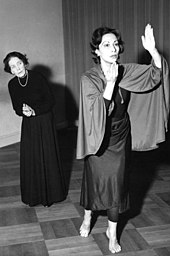
Dance
[edit]Exponents of expressionist dance included Mary Wigman, Rudolf von Laban, and Pina Bausch.[45]
Sculpture
[edit]Some sculptors used the Expressionist style, as for example Ernst Barlach. Other expressionist artists known mainly as painters, such as Erich Heckel, also worked with sculpture.[5]
Cinema
[edit]There was an Expressionist style in German cinema, important examples of which are Robert Wiene's The Cabinet of Dr. Caligari (1920), Paul Wegener's The Golem: How He Came into the World (1920), Fritz Lang's Metropolis (1927) and F. W. Murnau's Nosferatu, a Symphony of Horror (1922) and The Last Laugh (1924). The term "expressionist" is also sometimes used to refer to stylistic devices thought to resemble those of German Expressionism, such as film noir cinematography or the style of several of the films of Ingmar Bergman. More generally, the term expressionism can be used to describe cinematic styles of great artifice, such as the technicolor melodramas of Douglas Sirk or the sound and visual design of David Lynch's films.[46]
Literature
[edit]Journals
[edit]Two leading Expressionist journals published in Berlin were Der Sturm, published by Herwarth Walden starting in 1910,[47] and Die Aktion, which first appeared in 1911 and was edited by Franz Pfemfert. Der Sturm published poetry and prose from contributors such as Peter Altenberg, Max Brod, Richard Dehmel, Alfred Döblin, Anatole France, Knut Hamsun, Arno Holz, Karl Kraus, Selma Lagerlöf, Adolf Loos, Heinrich Mann, Paul Scheerbart, and René Schickele, and writings, drawings, and prints by such artists as Kokoschka, Kandinsky, and members of Der blaue Reiter.[48]
Drama
[edit]Oskar Kokoschka's 1909 playlet, Murderer, The Hope of Women is often termed the first expressionist drama. In it, an unnamed man and woman struggle for dominance. The man brands the woman; she stabs and imprisons him. He frees himself and she falls dead at his touch. As the play ends, he slaughters all around him (in the words of the text) "like mosquitoes." The extreme simplification of characters to mythic types, choral effects, declamatory dialogue and heightened intensity all would become characteristic of later expressionist plays.[49] The German composer Paul Hindemith created an operatic version of this play, which premiered in 1921.[50]
Expressionism was a dominant influence on early 20th-century German theatre, of which Georg Kaiser and Ernst Toller were the most famous playwrights. Other notable Expressionist dramatists included Reinhard Sorge, Walter Hasenclever, Hans Henny Jahnn, and Arnolt Bronnen. Important precursors were the Swedish playwright August Strindberg and German actor and dramatist Frank Wedekind. During the 1920s, Expressionism enjoyed a brief period of influence in American theatre, including the early modernist plays by Eugene O'Neill (The Hairy Ape, The Emperor Jones and The Great God Brown), Sophie Treadwell (Machinal) and Elmer Rice (The Adding Machine).[51]
Expressionist plays often dramatise the spiritual awakening and sufferings of their protagonists. Some utilise an episodic dramatic structure and are known as Stationendramen (station plays), modeled on the presentation of the suffering and death of Jesus in the Stations of the Cross. Strindberg had pioneered this form with his autobiographical trilogy To Damascus. These plays also often dramatise the struggle against bourgeois values and established authority, frequently personified by the Father. In Sorge's The Beggar, (Der Bettler), for example, the young hero's mentally ill father raves about the prospect of mining the riches of Mars and is finally poisoned by his son. In Bronnen's Parricide (Vatermord), the son stabs his tyrannical father to death, only to have to fend off the frenzied sexual overtures of his mother.[52]
In Expressionist drama, the speech may be either expansive and rhapsodic, or clipped and telegraphic. Director Leopold Jessner became famous for his expressionistic productions, often set on stark, steeply raked flights of stairs (having borrowed the idea from the Symbolist director and designer, Edward Gordon Craig). Staging was especially important in Expressionist drama, with directors forgoing the illusion of reality to block actors in as close to two-dimensional movement. Directors also made heavy use of lighting effects to create stark contrast and as another method to heavily emphasize emotion and convey the play or a scene's message.[53]
German expressionist playwrights:
- Georg Kaiser (1878)
- Ernst Toller (1893–1939)
- Hans Henny Jahnn (1894–1959)
- Reinhard Sorge (1892–1916)
- Bertolt Brecht (1898–1956)
Playwrights influenced by Expressionism:
- Seán O'Casey (1880–1964)[54]
- Eugene O'Neill (1885–1953)
- Elmer Rice (1892–1967)
- Tennessee Williams (1911–1983)[55]
- Arthur Miller (1915–2005)
- Samuel Beckett (1906–1989)[56]
Poetry
[edit]Among the poets associated with German Expressionism were:
- Jakob van Hoddis
- Georg Trakl
- Walter Rheiner
- Gottfried Benn
- Georg Heym
- Else Lasker-Schüler
- Ernst Stadler
- August Stramm
- Rainer Maria Rilke (1875–1926): The Notebooks of Malte Laurids Brigge (1910)[57]
- Geo Milev
Other poets influenced by expressionism:
Prose
[edit]In prose, the early stories and novels of Alfred Döblin were influenced by Expressionism,[60] and Franz Kafka is sometimes labelled an Expressionist.[61] Some further writers and works that have been called Expressionist include:
- Franz Kafka (1883–1924): "The Metamorphosis" (1915), The Trial (1925), The Castle (1926)[62]
- Alfred Döblin (1878–1957): Berlin Alexanderplatz (1929)[63]
- Wyndham Lewis (1882–1957)[64]
- Djuna Barnes (1892–1982): Nightwood (1936)[65]
- Malcolm Lowry (1909–1957): Under the Volcano (1947)
- Ernest Hemingway[66]
- James Joyce (1882–1941): "The Nighttown" section of Ulysses (1922)[67]
- Patrick White (1912–1990)[68]
- D. H. Lawrence[69]
- Sheila Watson: Double Hook[70]
- Elias Canetti: Auto-da-Fé[71]
- Thomas Pynchon[72]
- William Faulkner[73]
- James Hanley (1897–1985)[74]
- Raul Brandão (1867–1930): Húmus (1917)
- Leonid Andreyev (1871–1919): Devil's Diary (1919)
Music
[edit]The term expressionism "was probably first applied to music in 1918, especially to Schoenberg", because like the painter Kandinsky he avoided "traditional forms of beauty" to convey powerful feelings in his music.[75] Arnold Schoenberg, Anton Webern and Alban Berg, the members of the Second Viennese School, are important Expressionists (Schoenberg was also an expressionist painter).[76] Other composers that have been associated with expressionism are Krenek (the Second Symphony), Paul Hindemith (The Young Maiden), Igor Stravinsky (Japanese Songs), Alexander Scriabin (late piano sonatas) (Adorno 2009, 275). Another significant expressionist was Béla Bartók in early works, written in the second decade of the 20th century, such as Bluebeard's Castle (1911),[77] The Wooden Prince (1917),[78] and The Miraculous Mandarin (1919).[79] Important precursors of expressionism are Richard Wagner (1813–1883), Gustav Mahler (1860–1911), and Richard Strauss (1864–1949).[80]
Theodor Adorno describes expressionism as concerned with the unconscious, and states that "the depiction of fear lies at the centre" of expressionist music, with dissonance predominating, so that the "harmonious, affirmative element of art is banished" (Adorno 2009, 275–76). Erwartung and Die Glückliche Hand, by Schoenberg, and Wozzeck, an opera by Alban Berg (based on the play Woyzeck by Georg Büchner), are examples of Expressionist works.[81] If one were to draw an analogy from paintings, one may describe the expressionist painting technique as the distortion of reality (mostly colors and shapes) to create a nightmarish effect for the particular painting as a whole. Expressionist music roughly does the same thing, where the dramatically increased dissonance creates, aurally, a nightmarish atmosphere.[82]
Architecture
[edit]
In architecture, two specific buildings are identified as Expressionist: Bruno Taut's Glass Pavilion of the Cologne Werkbund Exhibition (1914), and Erich Mendelsohn's Einstein Tower in Potsdam, Germany completed in 1921. The interior of Hans Poelzig's Berlin theatre (the Grosse Schauspielhaus), designed for the director Max Reinhardt, is also cited sometimes. The influential architectural critic and historian Sigfried Giedion, in his book Space, Time and Architecture (1941), dismissed Expressionist architecture as a part of the development of functionalism. In Mexico, in 1953, German émigré Mathias Goeritz published the Arquitectura Emocional ("Emotional Architecture") manifesto with which he declared that "architecture's principal function is emotion".[83] Modern Mexican architect Luis Barragán adopted the term that influenced his work. The two of them collaborated in the project Torres de Satélite (1957–58) guided by Goeritz's principles of Arquitectura Emocional.[84] It was only during the 1970s that Expressionism in architecture came to be re-evaluated more positively.[85][86]
See also
[edit]References
[edit]- ^ a b Bruce Thompson, University of California, Santa Cruz, lecture on Weimar culture/Kafka'a Prague Archived 2010-01-11 at the Wayback Machine
- ^ Chris Baldick Concise Oxford Dictionary of Literary Terms, entry for Expressionism
- ^ a b Victorino Tejera, 1966, pages 85,140, Art and Human Intelligence, Vision Press Limited, London
- ^ The Oxford Illustrated Dictionary, 1976 edition, page 294
- ^ a b c d e Gombrich, E.H. (1995). The Story of Art (16. ed. (rev., expanded and redesigned). ed.). London: Phaidon. pp. 563–568. ISBN 978-0714832470.
- ^ Garzanti, Aldo (1974) [1972]. Enciclopedia Garzanti della letteratura (in Italian). Milan: Guido Villa. p. 963. page 241
- ^ John Willett, Expressionism. New York: World University Library, 1970, p.25; Richard Sheppard, "German Expressionism", in Modernism: 1890–1930, ed. Bradbury & McFarlane, Harmondsworth: Penguin Books, 1976, p.274.
- ^ Cited in Donald E. Gordon, Expressionism: Art and Ideas. New Haven: Yale University Press, 1987, p. 175.
- ^ R. S. Furness, Expressionism. London: Methuen, pp.2–14; Willett, pp. 20–24.
- ^ Richard Sheppard, p.274.
- ^ Note the parallel French movement Fauvism and the English Vorticism: "The Fauvist movement has been compared to German Expressionism, both projecting brilliant colors and spontaneous brushwork, and indebted to the same late nineteenth-century sources, especially Van Gogh." Sabine Rewald, "Fauvism", In Heilbrunn Timeline of Art History. New York: The Metropolitan Museum of Art, 2000–. http://www.metmuseum.org/toah/hd/fauv/hd_fauv.htm (October 2004); and "Vorticism can be thought of as English Expressionism." Sherrill E. Grace, Regression and Apocalypse: Studies in North American Literary Expressionism. Toronto: University of Toronto Press, 1989, p. 26.
- ^ Sherrill E. Grace, Regression and Apacaypse: Studies in North American Literary Expressionism. Toronto: University of Toronto Press, 1989, p.26).
- ^ Richard Murphy, Theorizing the Avant-Garde: Modernism, Expressionism, and the Problem of Postmodernity. Cambridge, Cambridge University Press,1999, p. 43.
- ^ Richard Murphy, p. 43.
- ^ Murphy, especially pp. 43–48; and Walter H. Sokel, The Writer in Extremis. Stanford, California: Stanford University Press, 1959, especially Chapter One.
- ^ Britannica Online Encyclopaedia (February, 2012).
- ^ Ragon, Michel (1968). Expressionism. Heron. ISBN 9780900948640.
There is no doubt that Expressionism is Baroque in essence
- ^ Benjamin, Walter (1998). Origin of German Tragic Drama. London: Verso. ISBN 978-1-85984-899-9.
- ^ Pedullà, Gabriele; Arbasino, Alberto (2003). "Sull'albero di ciliegie – Conversando di letteratura e di cinema con Alberto Arbasino" [On the cherry tree – Conversations on literature and cinema with Alberto Arbasino]. CONTEMPORANEA Rivista di studi sulla letteratura e sulla comunicazione.
L'espressionismo non rifugge dall'effetto violentemente sgradevole, mentre invece il barocco lo fa. L'espressionismo tira dei tremendi «vaffanculo», il barocco no. Il barocco è beneducato (Expressionism doesn't shun the violently unpleasant effect, while Baroque does. Expressionism throws some terrific "Fuck yous", Baroque doesn't. Baroque is well-mannered.)
- ^ Ian Chilvers, The Oxford dictionary of art, Volume 2004, Oxford University Press, p. 506. ISBN 0-19-860476-9
- ^ Ian Buruma, "Desire in Berlin", New York Review of Books, December 8, 2008, p. 19.
- ^ "The Jewish painters of l'École de Paris-from the Holocaust to today". Jews, Europe, the XXIst century. 2021-11-25. Retrieved 2023-11-19.
" l'École de Paris is a term coined by the art critic André Warnod in 1925, in the magazine Comœdia, to define the group formed by foreign painters in Paris. The École de Paris does not designate a movement or a school in the academic sense of the term, but a historical fact. In Warnod's mind, this term was intended to counter a latent xenophobia rather than to establish a theoretical approach.
- ^ "Ecole de Paris: French Art School Led by Picasso". www.visual-arts-cork.com. Retrieved 2023-12-02.
- ^ Nieszawer, Nadine (2020). Histoire des Artistes Juifs de l'École de Paris: Stories of Jewish Artists of the School of Paris (in French). France. ISBN 979-8633355567.
{{cite book}}: CS1 maint: location missing publisher (link) - ^ "Alexandre FRENEL". Bureau d’art Ecole de Paris. 2019-01-02. Retrieved 2023-11-19.
- ^ "Marc CHAGALL". Bureau d’art Ecole de Paris. 2019-01-02. Retrieved 2023-11-19.
- ^ Barzel, Amnon (1974). Frenel Isaac Alexander. Israel: Masada. p. 14.
- ^ Lurie, Aya (2005). Treasured in the Heart: Haim Gliksberg's Portraits. Tel Aviv. ISBN 978-9657161234.
{{cite book}}: CS1 maint: location missing publisher (link) - ^ Roditi, Eduard (1968). "The School of Paris". European Judaism: A Journal for the New Europe, 3(2), 13–20.
- ^ Ofrat, Gideon (2012). The Birth of Secular Art from the Zionist Spirit (in Hebrew). Jerusalem: Carmel. p. 234.
- ^ "Hartley, Marsden", Oxford Art Online
- ^ Bram Dijkstra, American expressionism : art and social change, 1920–1950,(New York : H.N. Abrams, in association with the Columbus Museum of Art, 2003.) ISBN 0-8109-4231-3, ISBN 978-0-8109-4231-8
- ^ Judith Bookbinder, Boston modern: figurative expressionism as alternative modernism (Durham, N.H. : University of New Hampshire Press; Hanover : University Press of New England, ©2005.) ISBN 1-58465-488-0, ISBN 978-1-58465-488-9
- ^ Thomas B. Hess, “The Many Deaths of American Art,” Art News 59 (October 1960), p.25
- ^ Paul Schimmel and Judith E Stein, The Figurative fifties : New York figurative expressionism (Newport Beach, California : Newport Harbor Art Museum : New York : Rizzoli, 1988.) ISBN 978-0-8478-0942-4
- ^ “Editorial,” Reality, A Journal of Artists’ Opinions (Spring 1954), p. 2.
- ^ Flight lyric, Paris 1945–1956, texts Patrick-Gilles Persin, Michel and Pierre Descargues Ragon, Musée du Luxembourg, Paris and Skira, Milan, 2006, 280 p. ISBN 88-7624-679-7.
- ^ Caroline A. Jones, Bay Area figurative art, 1950–1965, (San Francisco, California : San Francisco Museum of Modern Art; Berkeley : University of California Press, ©1990.) ISBN 978-0-520-06842-1
- ^ American Abstract and Figurative Expressionism: Style Is Timely Art Is Timeless (New York School Press, 2009.) ISBN 978-0-9677994-2-1 pp. 44–47; 56–59; 80–83; 112–115; 192–195; 212–215; 240–243; 248–251
- ^ Marika Herskovic, American Abstract Expressionism of the 1950s An Illustrated Survey, Archived 2007-09-29 at the Wayback Machine (New York School Press, 2000. ISBN 0-9677994-1-4. pp. 46–49; pp. 62–65; pp. 70–73; pp. 74–77; pp. 94–97; 262–264
- ^ American Abstract and Figurative Expressionism: Style Is Timely Art Is Timeless: An Illustrated Survey With Artists' Statements, Artwork and Biographies(New York School Press, 2009. ISBN 978-0-9677994-2-1. pp.24–27; pp.28–31; pp.32–35; pp. 60–63; pp.64–67; pp.72–75; pp.76–79; pp. 112–115; 128–131; 136–139; 140–143; 144–147; 148–151; 156–159; 160–163;
- ^ Ryan, David (2002). Talking painting: dialogues with twelve contemporary abstract painters, p.211, Routledge. ISBN 0-415-27629-2, ISBN 978-0-415-27629-0. Available on Google Books.
- ^ "Exhibition archive: Expanding Boundaries: Lyrical Abstraction", Boca Raton Museum of Art, 2009. Retrieved 25 September 2009.
- ^ "John Seery", National Gallery of Australia. Retrieved 25 September 2009.
- ^ Walther, Suzanne (23 December 1997). The Dance Theatre of Kurt Jooss. Routledge. p. 23. ISBN 978-1-135-30564-2. Retrieved 29 May 2018.
- ^ Maria Pramaggiore; Tom Wallis (2005). Film: A Critical Introduction. Laurence King Publishing. pp. 88–90. ISBN 978-1-85669-442-1. Retrieved 29 May 2018.
- ^ "Der Sturm.". Encyclopædia Britannica Online. Encyclopædia Britannica Inc. 2012. Retrieved 21 January 2012.
- ^ Günter Berghaus (25 October 2012). International Futurism in Arts and Literature. Walter de Gruyter. pp. 285–286. ISBN 978-3-11-080422-5. Retrieved 29 May 2018.
- ^ David Graver (1995). The Aesthetics of Disturbance: Anti-art in Avant-garde Drama. University of Michigan Press. p. 65. ISBN 0-472-10507-8. Retrieved 29 May 2018.
- ^ John Lincoln Stewart (1991). Ernst Krenek: The Man and His Music. University of California Press. p. 82. ISBN 978-0-520-07014-1. Retrieved 29 May 2018.
- ^ Jonathan Law (28 October 2013). The Methuen Drama Dictionary of the Theatre. A&C Black. ISBN 978-1-4081-4591-3. Retrieved 29 May 2018.
- ^ J. L. Styan (9 June 1983). Modern Drama in Theory and Practice: Volume 3, Expressionism and Epic Theatre. Cambridge University Press. p. 4. ISBN 978-0-521-29630-4. Retrieved 29 May 2018.
- ^ Fulton, A. R. (1944). "Expressionism: Twenty Years After". The Sewanee Review. 52 (3): 398–399. JSTOR 27537525.
- ^ Furness, pp.89–90.
- ^ Stokel, p.1.
- ^ Stokel, p.1; Lois Oppenheimer, The Painted Word: Samuel Beckett's Dialogue with Art. Ann Arbor: University of Michigan Press, 2000, pp.74, 126–7, 128; Jessica Prinz, "Resonant Images: Beckett and German Expressionism", in Samuel Beckett and the Arts: Music, Visual Arts, and Non-Print Media, ed. Lois Oppenheim. New York: Garland Publishing, 1999.
- ^ Ulf Zimmermann, "Expressionism and Döblin's Berlin Alexanderplatz, in Passion and Rebellion
- ^ R. S. Furness, Expressionism. London: Methuen, 1973, p.81.
- ^ "Lyrisk ekspressionisme | lex.dk". 29 January 2020.
- ^ Cowan, Michael (2007). "Die Tücke Des Körpers: Taming The Nervous Body In Alfred Döblin's 'Die Ermordung Einer Butterblume' And 'Die Tänzerin Und Der Leib'". Seminar: A Journal of Germanic Studies. 43 (4): 482–498. doi:10.3138/seminar.43.4.482. S2CID 197837029.
- ^ Walter H. Sokel, The Writer in Extremis. Stanford, California: Stanford University Press, 1959, pp 3, 29, 84 especially; Richard Murphy, Theorizing the Avant-Garde. Cambridge, Cambridge University Press,1999, especially pp 41,142.
- ^ Silvio Vietta, "Franz Kafka, Expressionism, and Reification" in Passion and Rebellion: The Expressionist Heritage, eds. Stephen Bronner and Douglas Kellner. New York: Universe Books, 1983 pp, pp.201–16.
- ^ Richard Murphy, Theorizing the Avant-Garde: Modernism, Expressionism and the Problem of Postmodernity. Cambridge: Cambridge University Press, 1999, pp.74–141; Ulf Zimmermann, "Expressionism and Döblin's Berlin Alexanderplatz " in Passion and Rebellion, pp.217–234.
- ^ Sheila Watson, Wyndham Lewis Expressionist. Ph.D Thesis, University of Toronto, 1965.
- ^ Sherrill E. Grace, Regression and Apocalypse: Studies in North American Literary Expressionism. Toronto: University of Toronto Press, 1989, pp.141–162.
- ^ Raymond S. Nelson, Hemingway, Expressionist Artist. Ames, Iowa University Press, 1979; Robert Paul Lamb, Art matters: Hemingway, Craft, and the Creation of the Modern Short Story. Baton Rouge: Louisiana State University Press, c.2010.
- ^ Walter H. Sokel, The Writer in Extremis. Stanford, California: Stanford University Press, 1959, p.1; R. S. Furness, Expressionism. London: Methuen, 1973, p. 81.
- ^ Sherrill E. Grace, p.7.
- ^ Sherrill E. Grace, p.7
- ^ Sherrill E. Grace, pp 185–209.
- ^ Sherrill E. Grace, p.12.
- ^ Sherrill E. Grace, p.7, 241–3.
- ^ Jeffrey Stayton, "Southern Expressionism: Apocalyptic Hillscapes, Racial Panoramas, and Lustmord in William Faulkner’s Light in August". The Southern Literary Journal, Volume 42, Number 1, Fall 2009, pp. 32–56.
- ^ Ken Worpole, Dockers and Detectives. London: Verso Editions, 1983, pp. 77–93.
- ^ The Norton Grove Concise Encyclopedia of Music, ed Stanley Sadie. New York: Norton1991, p. 244.
- ^ Theodor Adorno, Night Music: Essays on Music 1928–1962. (London: Seagull, 2009), p.274-8.
- ^ Nicole V. Gagné, Historical Dictionary of Modern and Contemporary Classical Music (Plymouth, England: Scarecrow Press, 2011), p.92.
- ^ Andrew Clements, "Classical preview: The Wooden Prince", The Guardian, 5 May 2007.
- ^ The Cambridge Companion to Bartók, ed. Amanda Bayley (Cambridge: Cambridge University Press, 2001), p.152.
- ^ "Expressionism," Microsoft® Encarta® Online Encyclopedia 2000. "MSN Encarta : Online Encyclopedia, Dictionary, Atlas, and Homework". Archived from the original on 2009-10-30. Retrieved 2012-06-29.; Donald Mitchell, Gustav Mahler: The Wunderhorn Years: Chronicles and Commentaries. Rochester, NY: Boydell Press, 2005
- ^ Edward Rothstein New York Times Review/Opera: "Wozzeck; The Lyric Dresses Up Berg's 1925 Nightmare In a Modern Message". New York Times February 3, 1994; Theodor Adorno, Night Music (2009), p.276.
- ^ Theodor Adorno, Night Music (2009), pp275-6.
- ^ Mathias Goeritz, "El manifiesto de arquitectura emocional", in Lily Kassner, Mathias Goeritz, UNAM, 2007, p. 272-273
- ^ George F. Flaherty (16 August 2016). Hotel Mexico: Dwelling on the '68 Movement. Univ of California Press. p. 93. ISBN 978-0-520-29107-2. Retrieved 29 May 2018.
- ^ Ben Farmer; Dr Hentie J Louw; Hentie Louw; Adrian Napper (2 September 2003). Companion to Contemporary Architectural Thought. Routledge. p. 359. ISBN 978-1-134-98381-0. Retrieved 29 May 2018.
- ^ Dennis Sharp (2002). Twentieth Century Architecture: A Visual History. Images Publishing. p. 297. ISBN 978-1-86470-085-5. Retrieved 29 May 2018.
Further reading
[edit]- Antonín Matějček cited in Gordon, Donald E. (1987). Expressionism: Art and Idea, p. 175. New Haven: Yale University Press. ISBN 9780300033106
- Frank Krause (ed.), Expressionism and Gender / Expressionismus und Geschlecht. Göttingen: V&R unipress, 2010, ISBN 3899717171
- Jonah F. Mitchell (Berlin, 2003). Doctoral thesis Expressionism between Western modernism and Teutonic Sonderweg. Courtesy of the author.
- Friedrich Nietzsche (1872). The Birth of Tragedy Out of The Spirit of Music. Trans. Clifton P. Fadiman. New York: Dover, 1995. ISBN 0-486-28515-4.
- Judith Bookbinder, Boston modern: figurative expressionism as alternative modernism, (Durham, N.H.: University of New Hampshire Press; Hanover: University Press of New England, ©2005.) ISBN 1-58465-488-0, ISBN 978-1-58465-488-9
- Bram Dijkstra, American expressionism: art and social change, 1920–1950, (New York: H.N. Abrams, in association with the Columbus Museum of Art, 2003.) ISBN 0-8109-4231-3, ISBN 978-0-8109-4231-8
- Ditmar Elger Expressionism-A Revolution in German Art ISBN 978-3-8228-3194-6
- Paul Schimmel and Judith E Stein, The Figurative fifties: New York figurative expressionism, The Other Tradition (Newport Beach, California: Newport Harbor Art Museum: New York: Rizzoli, 1988.) ISBN 978-0-8478-0942-4 ISBN 978-0-91749312-6
- Marika Herskovic, American Abstract and Figurative Expressionism: Style Is Timely Art Is Timeless (New York School Press, 2009.) ISBN 978-0-9677994-2-1.
- Lakatos Gabriela Luciana, Expressionism Today, University of Art and Design Cluj Napoca, 2011
External links
[edit]- Hottentots in tails – a turbulent history of the group by Christian Saehrendt at signandsight.com
- German Expressionism – a free resource with paintings from German expressionists (high-quality) (archived 20 February 2006)


 French
French Deutsch
Deutsch